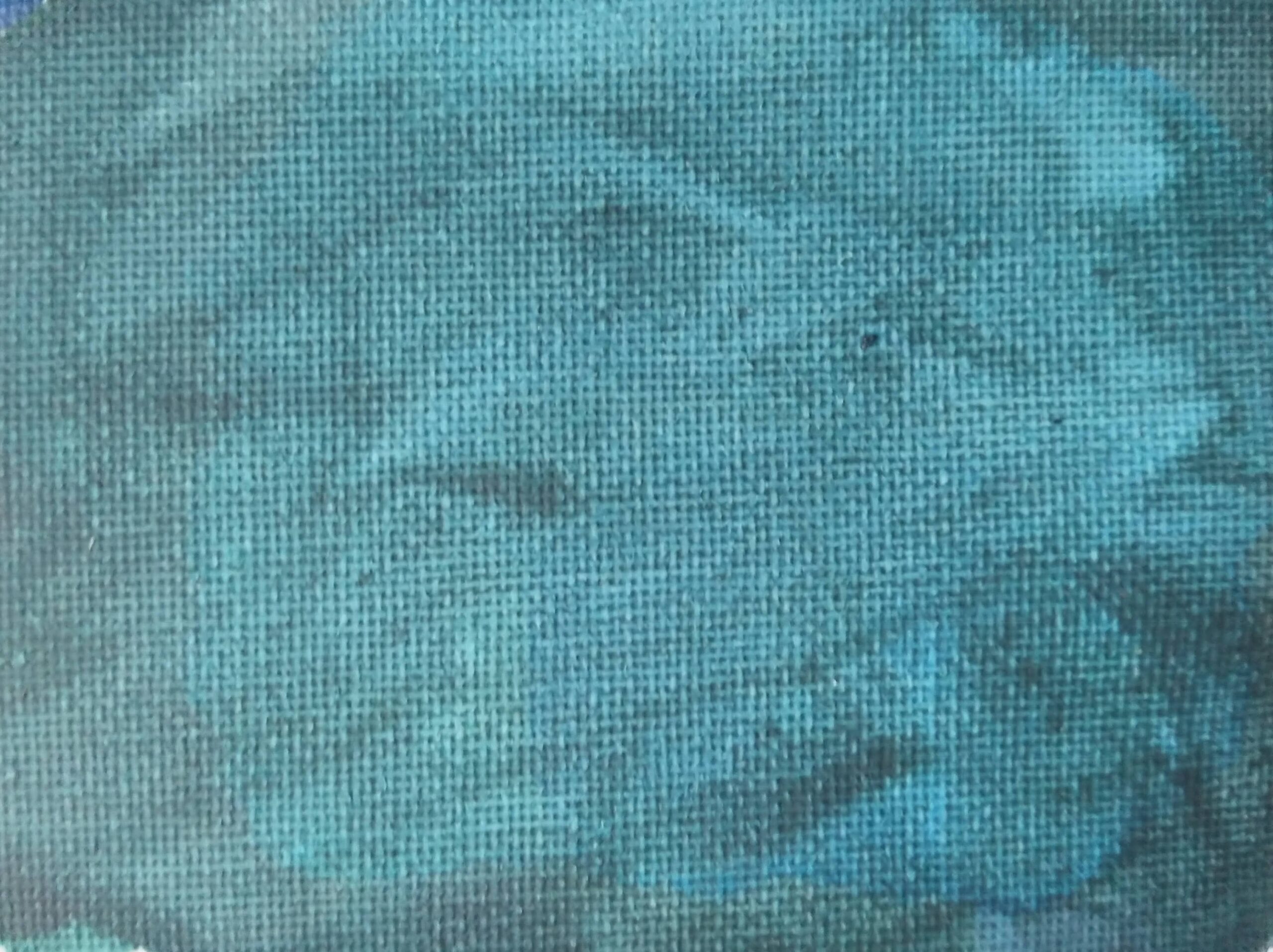Watery acrylic paint can be annoying both for artists as well as painters. If you are painting horizontally watery acrylic paint can run down, or it may not even stick to the surface well. You might be wondering why acrylic paint becomes watery.
As a whole, acrylic paint becomes watery when the paint is kept without movement for a long time, when the paint is old and gone bad, or when kept cold in winter. Try stirring the paint well first. If the paint is naturally watery try mixing it with a chemical paint thickener.
Watery acrylic paint can result even if you buy them in a low-quality brand or the whole batch of acrylic paint might be defective. These will be discussed later in this article as well as some DIY acrylic paint thickening techniques.
Why acrylic paint becomes watery and how to fix it?
There are many reasons why acrylic paint can become watery. Watery acrylic paints can occur in both artist acrylic paint and acrylic house paints. When acrylic paint is too thinned or watery, it can be a downside for most of us, especially if the paint is watery because it is separated.
Watery paints are difficult to apply vertically and you may not want runny acrylic paint. This can be easily fixed if you know why watery acrylic paints happened and how to fix watery acrylic paint in each case. I have described both reasons and solutions below in detail.
Paint sitting there for a long time without movement
This is one of the main reasons why acrylic paint is watery. When you have acrylic paint that sits in your house or on the store shelves for a long time it can become watery. Usually, you will see water on top of solid paint particles.
In most cases, if you mix acrylic paint well, the separated liquid and solid paint particles will come together and form paint. You can use this revived paint without any problem.
How to fix…
If the separated acrylic paint is house paint, you can use a paint mixing paddle to mix the content in the paint well. Put the mixer into the paint can and start mixing until it forms a thick, creamy consistency of normal acrylic paint.
You can do the same for artist acrylic paint in jars or tubs. Use a clean palette knife, wipe the palette knife with some rubbing alcohol, then use it to thoroughly mix the watery acrylic paint in the tub or jar.
If the paint is in a tube, you can squeeze the tube in several locations and move the paint until it is properly mixed. This is somewhat harder to do and should be done carefully without breaking the paint tube. So instead you can mix the paint with the separated liquid once the paint is taken out of the tube. You can use a clean palette knife for this as well.
I have written a whole article about ‘How can you tell if acrylic paint is bad?‘. You can find the common signs of bad acrylic paint, and how to fix and prevent them in that article.
Acrylic paint is low in quality
Low-quality acrylic paints can be a bummer in most cases. If you are an artist and have used craft-quality acrylic paint you know what I am talking about. Craft quality acrylic paint like Deco Art usually has a thin consistency and is less pigmented.
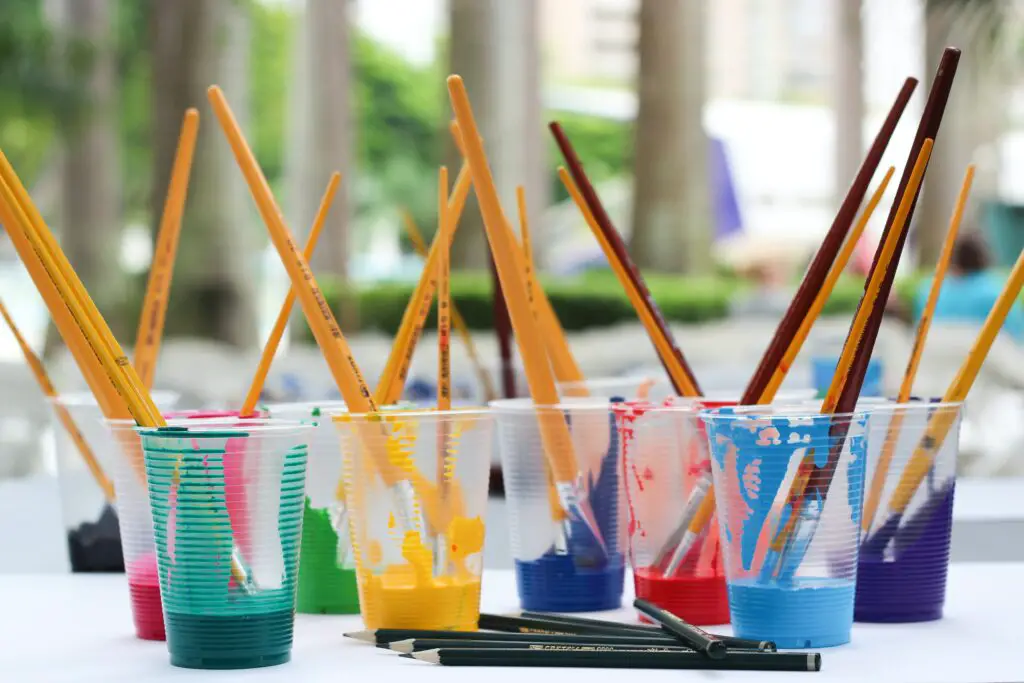
In most cases, craft-quality acrylic paints are available in this thin consistency. But with artist-grade acrylic paints, you can get heavy body acrylic paints with a thicker consistency. If you want to increase the thickness of either artist’s grade or craft quality acrylic paint you can use an acrylic paint thickening medium. This will be discussed later in the article.
There can be low-quality acrylic house paints with a thinner watery consistency. In this case, you can use a chemical acrylic paint thickener like CIC Thickening Paste, CW-9002. However, I asked Dulux Paints if they have any recommendations for a thickener for their acrylic paints. Here is what they said;
We don’t manufacture a paint thickener, nor do we have any to recommend. You might find something in a DIY or hardware store but we cannot guarantee it’ll be compatible with our paint.
Damon Bain, Technical Advisor for Akzo Nobel
So even if you use a thicker like CIC Thickening Paste, CW-9002, or any other thickener from the hardware store, you might have to test it with your paint first before doing the paint job. However, I do not recommend DIY thickeners and you will find why later in the article.
The acrylic paint is made to be watery
Some acrylic paints are made to be in watery consistency. It is not because of a defect in acrylic paint or because it is low in quality. Artist acrylic paints are available in different watery consistencies such as soft body and ink. If you see any of those words on your paint bottle, that is probably how the paint is made to be.
If you want to thicken up soft body acrylics or ink acrylic paints you can add acrylic paint thickener medium. This is the best archival method of thickening acrylic paint.
There can be some acrylic house paints that are made to be watery or very runny. In this case, the best choice would be using a chemical acrylic paint thickener like CIC Thickening Paste, CW-9002.
You can also let the water in acrylic house paint evaporate, by setting some of the paint out on a container exposed to air for around an hour. If it is still not thickened enough you can set it out for another few hours. Make sure to stir the paint from hour to hour.
Keeping the paint in cold temperatures
If acrylic paint is kept in cold temperatures below 50oF (10oC), the paint can get separated. You will see a watery liquid on top of acrylic paint. This usually happens if you keep your paints in cold during winter.
Always store acrylic paint between 70 to 90oF( 21oC to 32oC). So you can store the paint inside your house where a heating system is in place to keep your paints at the ideal temperature, during winter. This will keep your paints from separating.
Purchasing a bad batch of paint
Sometimes paints can have manufacturing defects. The batch of paint manufactured might be very watery or separated. You can always ask for a replacement from the retailer you purchased the paint from if you see the newly purchased paint is abnormally watery.
I know this is a very obvious solution, but thought it would be worth mentioning it here
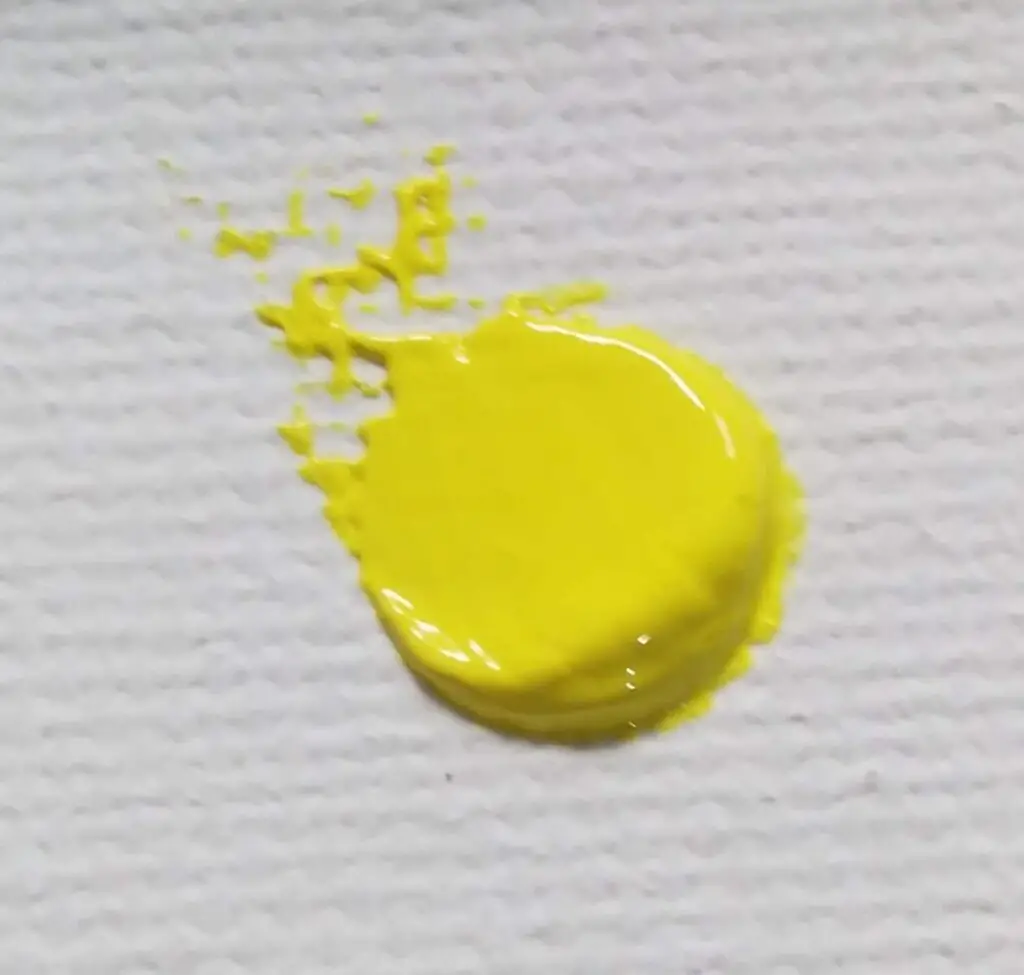
How to make watery acrylic paint thicker?
I have mentioned some of the ways to thicken acrylic paints above. There are two ways of thickening acrylic paint. One way is nonarchival and the other way is archival.
You can thicken acrylic paint with archival materials. These are acrylic mediums or thickeners especially made to thicken acrylic paint. You can also use some DIY materials which are popular among artists to thicken acrylic paints. However, using DIY materials is not an archival method.
Let’s discuss these in detail below.
Archival ways of thickening acrylic paint
If you are using artist acrylic paints you can get acrylic thickening mediums. Liquitex has a thickening gel called Liquitex Additives Liquithick Thickening Gel. You can get it for the best price from the Blick Art Materials store online.
With acrylic thickening mediums, less can do more. The more medium you add, the thicker the paint would be. Using acrylic thickening mediums is by far the best choice. The paint film is flexible even though it is thick just like acrylic paint.
The paint mixed with thickening acrylic medium does not crack and is very archival just like using acrylic paint by itself. With art mediums, you always get what you pay for.
If you are using acrylic house paints you can use a water-based thickener like CIC Thickening Paste, CW-9002. You will need to test the compatibility of the thickener with your paint first before doing the actual paint job.
There are also some archival DIY methods you can do with acrylic house paints like evaporating acrylic house paint. You can also heat house paints in a bucket warmer for 1 hour to thicken the paint. But I am not so sure if that will work with acrylic house paints.
Non-archival ways of thickening acrylic paint
There are so many DIY ways of thickening acrylic paint you can find on the web. One of the popular ways is using corn starch to thicken acrylic paint. Mixing talcum powder is another popular method to thicken acrylic paint.
I thought of trying these two methods and sharing the results with you. Unfortunately, I did not have good results with any of those DIY methods. I have also used an acrylic gel medium and acrylic paint by itself for comparison.
For this experiment, I used student-grade acrylic paint, corn starch, talcum powder, and acrylic gel mediums. All paint mixtures were applied to a piece of the baking sheet using a palette knife.
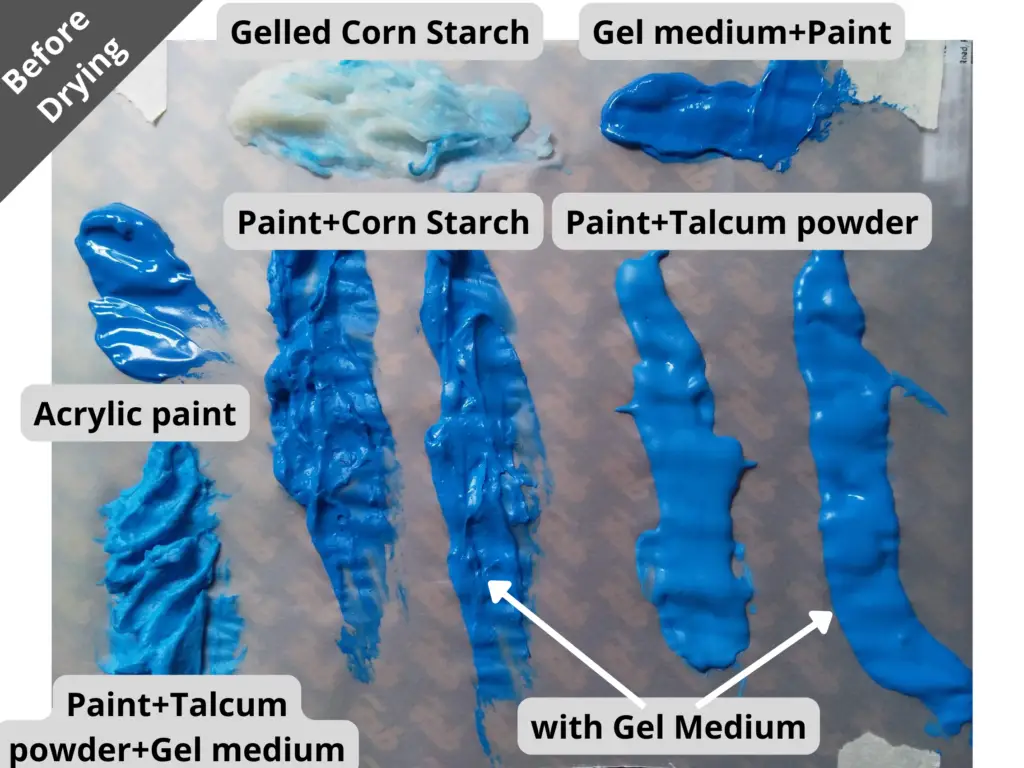
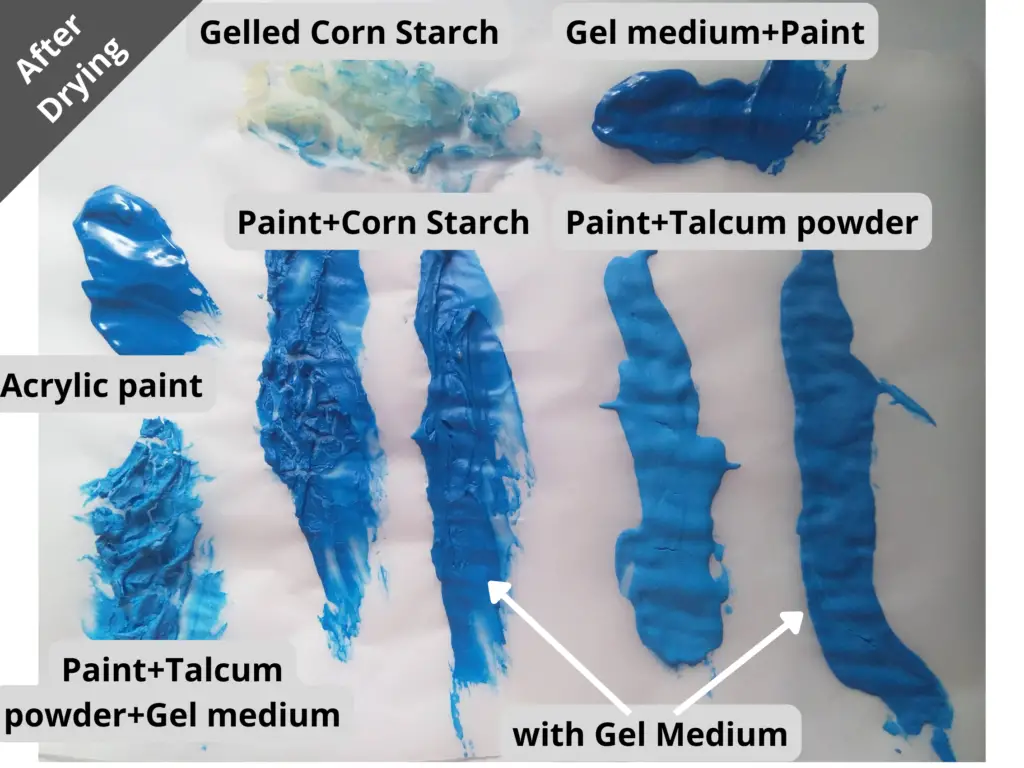
Corn starch
I added approximately a tablespoon of corn starch to half a cup of water and heated it until a gel-like consistency is formed. After cooling it down for a few minutes I mixed gelled corn starch with student-grade thin acrylic paint. Then applied a swatch of it on the baking sheet.
After 24 hours you can see the paint has cracked into huge ridges. I do not recommend this corn starch method to anyone. Maybe a small amount of the diluted corn starch mixture will not crack as much.
I have also mixed a little acrylic gel medium with the corn starch and acrylic paint mixture. This mixture held up pretty nicely and only had smaller cracks. When I folded the paper with the swatch the paint mixture did not break. So you can use corn starch with a little acrylic medium but not by itself.
Talcum powder
Mixing with talcum powder is another popular method of thickening acrylic paint. I have mixed talcum powder with acrylic paint, however, the consistency is hard to get right. You will need to add a little water to make the consistency right.
You will need more talcum power when mixing with water and acrylic paint. Otherwise, the paint swatch will get thinner like what happened to me. However, the dried paint is very hard and not flexible at all. The paint cracked when drying.
I have tried mixing in some acrylic gel medium with talcum powder and acrylic paint, but that mixture is very hard and had cracks. Meaning the talcum powder paint swatch, been with acrylic gel medium was not flexible but hard and rigid, unlike acrylic paint.
So I do not recommend any of these DIY methods of thickening acrylic paints to anyone. I think using a thickening acrylic medium or even a gel medium will give good outcomes for the time and effort you have put into your painting.
You also need to remember that a gel medium will not thicken acrylic paint as much as a thickening medium. However, even an acrylic gel medium can increase the thickness of watery acrylic paint.
Conclusion
Watery acrylic paint can be a real bummer for most of us. Usually, it happens with old paints that sit there for a long time or when the paint is kept cold during winter. If you see watery liquid on top of paint solids try mixing the water and paint solids thoroughly. If that did not work you can add a thickening medium that is archival to acrylic paint.
I have written an article series about common acrylic paint questions and answers: part 1 and part 2. You can find answers to questions like this in the articles even before you face them.

